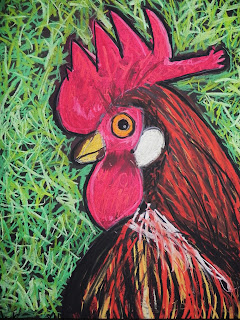PICASSO LA COQ CHALK ART
Learning Target
I can...- Create a Picasso Rooster using techniques learned in class
- Use shape (mismatching, fragmented, complex) color (whimsical, complex) and texture (implied, tactile) to mimic Spanish Painter Pablo Picasso
- Use design principles (composition, proportion, contrast) relating to the Neoclassic Period
- Define Whimsical (an art or idea that is unusual, playful, and unpredictable)
Lesson One
Day One, Art Start
1. Domestic Fowl- Rooster Parts (comb, gobbler, beak, claws, sickle feathers)
2. Roosters Off To See The World by Eric Carle
3. Discussion Questions "What differences do you notice between a real rooster and the rooster Pablo Picasso created? Whimsical- an art or idea that is unusual, playful, and unpredictable. What makes this rooster look surreal or whimsical? What message is this artwork trying to convey?"
Lesson Activities
1. Choose three shapes (mismatched, fragmented, complex) for the Rooster Body, Head, & Tail2. Add detailed features (beak, feathers, gobbler) to the Rooster Body, Head, and/or Tail
3. Use black oil pastel, ink pens, or sharpie markers to outline the Picasso Rooster
Reminder:
- Initials & Home Teacher on Back of Paper
Day Two, Art Start
1. The Rooster (Le Coq) (1938) Pablo PicassoUnicorn Rooster (Coq Licorne) (1952) Jean Dallaire
2. The Year of The Rooster by A.J.Fontaine
3. Famous Artist Quote "When first asked why Picasso painted the Rooster Series, he replied 'There have always been roosters, but like everything else in life we must discover them -roosters have always been seen but never as well as in American weather vanes.' What do you believe the artist meant by this comment?
Lesson Activities
1. Use black oil pastel, ink pens, or sharpie markers to finish outlining the Rooster2. Use color (analogous, complimentary) to fill in the lights and darks of the Rooster
3. Use pure color (white, black) to add highlights and shadows to ones Picasso Rooster
Day Three, Art Start
1. Retrieve Picasso Rooster for Assigned Table2. Set Up Studio Area (oil pastels, wipes, colored pencil)
Lesson Activities
1. Use color (analogous, complimentary) to finish filling in the lights and darks of the Rooster2. Use pure color (white, black) to finish adding highlights and shadows to the Rooster
3. Use baby wipes to blend colors (pure, analogous, complimentary) for a finished Picasso Rooster


























